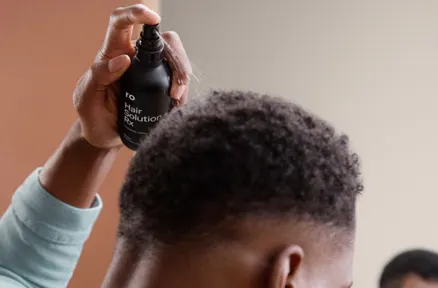Here's what we'll cover
Here's what we'll cover
Here's what we'll cover
Finasteride is an oral medication that is FDA-approved to treat hair loss and benign prostatic hyperplasia. When used to treat hair loss, it can be sold as the brand name Propecia and comes in a 1 mg dose. When used to treat BPH, it can be sold as the brand name Proscar and comes in a 5 mg dose.
Finasteride Important Safety Information: Read more about serious warnings and safety info.
How does it work?
Finasteride is known as a 5-alpha-reductase (5-AR) inhibitor. It works by preventing testosterone from converting into dihydrotestosterone (DHT), a hormone that is the major cause of male pattern baldness. In some men, DHT attacks the hair follicles, causing them to miniaturize, or shrink. In some cases, those follicles stop producing hair.
5-AR converts testosterone into DHT in the testicles and prostate. When 5-AR is inhibited, so is the production of DHT. Taking finasteride at a dosage of 1 mg a day can lower DHT levels by as much as 60% (Mysore, 2012).
According to a 2017 meta-analysis of studies published in the Journal of the American Academy of Dermatology, finasteride was found to be superior to placebo in regrowing hair. Researchers have concluded it's effective for promoting hair growth in men with male pattern baldness (Adil, 2017). And the American Hair Loss Association says finasteride stopped hair loss progression in 86% of men who took the drug in clinical trials, and 65% of them experienced increased hair growth (AHLA, n.d).
BPH can cause mild to moderate prostate enlargement, which can result in symptoms like frequent or urgent urination, difficulty starting urination, a weak urine stream. Finasteride is often prescribed in a 5 mg dose (brand name Proscar) to treat BPH. It works to shrink the prostate by preventing hormonal changes that cause prostate growth.
Finasteride interactions with other drugs
Always keep your healthcare provider apprised of any medications or supplements you're taking or plan to take while taking finasteride.
Finasteride may affect the results of the blood test used to detect prostate cancer.
Cytochrome P450 is a family of enzymes that helps the liver metabolize medications. Finasteride does not appear to affect the cytochrome P450-linked drug-metabolizing enzyme system. Compounds that have been tested in human trials include antipyrine, digoxin, propranolol, theophylline, and warfarin, and no clinically meaningful interactions were found (DailyMed, 2018).
Although studies about how finasteride interacts with each specific drug were not performed, finasteride doses of 1 mg or more were simultaneously used in studies alongside acetaminophen, acetylsalicylic acid, α-blockers, analgesics, angiotensin-converting enzyme (ACE) inhibitors, anticonvulsants, benzodiazepines, beta blockers, calcium-channel blockers, cardiac nitrates, diuretics, H2 antagonists, HMG-CoA reductase inhibitors, prostaglandin synthetase inhibitors (also referred to as NSAIDs), and quinolone anti-infectives. There was no evidence of clinically significant adverse interactions (DailyMed, 2018).
Talk with a healthcare provider about whether finasteride is right for you.
Alternatives to finasteride
If your healthcare provider advises that you shouldn't take finasteride, other alternatives are available for treating male pattern baldness and BPH. They include:
Minoxidil: An over-the-counter liquid or foam applied to the scalp twice a day to slow or stop the progression of male pattern baldness and thinning hair. It must be used continuously. If you discontinue minoxidil, new hair growth may reverse, and hair loss will continue.
Surgery: In hair transplantation, donor hairs are removed from the sides and back of the scalp (areas which are more resistant to DHT) and implanted into areas of male pattern baldness.
Laser treatment: Low-level laser light therapy (LLLT) is an FDA-cleared way to treat hair loss. These devices might come in the form of a wand you point at the scalp or a cap you can wear. They emit a constant red LED light that is believed to reduce inflammation and increase blood flow to the hair follicles.
According to a 2017 meta-review published in the Journal of the American Academy of Dermatology, both minoxidil and LLLT were found to be effective in regrowing hair lost to male pattern baldness (Adil, 2017).
PRP (platelet-rich plasma) treatments: In this treatment, a patient's blood is drawn and placed into a centrifuge to extract plasma that is injected into the scalp. The theory is that the growth factors in platelets can spur hair growth. A study published in the International Journal of Molecular Sciences found that PRP treatment increased the number of hairs and overall hair density compared to areas treated with a placebo (Gentile, 2017).
BPH treatments: If you can't take finasteride (brand name Proscar) for BPH, other treatments are available, including the medication dutasteride (brand name Avodart) and medications known as alpha blockers, which can relax the bladder and prostate to make urination easier. Your healthcare provider might also suggest minimally invasive surgery or laser therapy to reduce the size of the prostate.
DISCLAIMER
If you have any medical questions or concerns, please talk to your healthcare provider. The articles on Health Guide are underpinned by peer-reviewed research and information drawn from medical societies and governmental agencies. However, they are not a substitute for professional medical advice, diagnosis, or treatment.
References
Adil, A., & Godwin, M. (2017). The effectiveness of treatments for androgenetic alopecia: A systematic review and meta-analysis. Journal of the American Academy of Dermatology , 77 (1), 136–141.e5. doi.org/10.1016/j.jaad.2017.02.054. Retrieved from https://www.jaad.org/article/S0190-9622(17)30306-7/fulltext
American Hair Loss Association. (n.d.). Treatment. Retrieved July 7, 2020 from https://www.americanhairloss.org/men_hair_loss/treatment.html
DailyMed - FINASTERIDE tablet. (n.d.). Retrieved Oct. 2, 2020 from https://dailymed.nlm.nih.gov/dailymed/drugInfo.cfm?setid=81b424d3-8418-4497-9395-59eae6755230
Gentile, P., Cole, J. P., Cole, M. A., Garcovich, S., Bielli, A., Scioli, M. G., Orlandi, A., Insalaco, C., & Cervelli, V. (2017). Evaluation of Not-Activated and Activated PRP in Hair Loss Treatment: Role of Growth Factor and Cytokine Concentrations Obtained by Different Collection Systems. International Journal of Molecular Sciences , 18 (2), 408. doi.org/10.3390/ijms18020408. Retrieved from https://www.mdpi.com/1422-0067/18/2/408
Mysore, V. (2012). Finasteride and sexual side effects. Indian Dermatology Online Journal , 3 (1), 62–65. doi.org/10.4103/2229-5178.93496. Retrieved from https://journals.lww.com/idoj/pages/default.aspx










